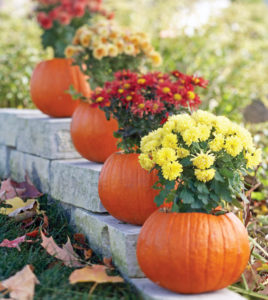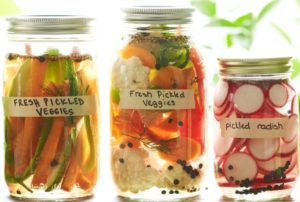September Gardening for Fall Fanatics
It is officially the first day of fall, as September 23 marks the Autumnal Equinox—the beginning of shorter days, cooler air, and watercolor forests.
Now that fall has arrived, summer gardeners are pocketing their trowels and slipping off their gloves, but cooler weather doesn’t necessarily put an end to gardening. In fact, there are various gardening chores to finish this September before the frost hits as well as ways to spruce up your yard into a stunning fall setting.
Organic Fall Décor
For fall enthusiasts, skeletal tree limbs, crimson leaves, and plump pumpkins are necessities for an exquisite fall scene. To complement this natural scenery, homeowners can decorate their porches using organic décor right from their own gardens.
For those who planted pumpkins in July eagerly awaiting this moment, these gourds can be used to decorate the front porch by dotting the porch steps and flanking the front door. They can also be carved, gutted, and used as decorative pots for fall flowers.

To make a pumpkin planter, find a pumpkin that is fat and round with a flat bottom, then scoop its innards with a trowel and fill the pumpkin one-third of the way full with potting soil. Plant colorful flowers or vibrant plants, like cabbage, in the pumpkin. Then, when the pumpkin begins to fade, plant it in the ground to use as natural fertilizer.
Tip: to make your pumpkin planter last as long as possible, use plants that don’t require much sunlight so your pumpkin can sit in the shade.
For other fall containers, find large ceramic pots or hanging wicker baskets for the front door. As with the pumpkin planter, fill these with stunning flowers. To make even more of a statement, use a variety of colors that pop and match porch décor, such as rugs and pillows.
Preparing for Spring
While spring is usually the last thing on our minds at the beginning of fall, it’s good to think ahead and start planting flowering bulbs.
Flower beds that line driveways and front porches make a statement, adding curb appeal to your home. Planting flowering bulbs in these beds will also plant smiles on the faces of passersby in the fading weeks of winter.
For splashes of color, plant tulips, scilla, crocus, and hyacinth. Dainty flowers—such as daffodils, summer snowflake, and Siberian squill—make for beautiful flower beds that add softer tones of color. These spring-blooming bulbs take root in the fall and bloom in early spring, sometimes even in the snow. Simply plant them in a sunlight-heavy spot, apply fertilizer, and wait!
September Garden Clearing
In September, most of our summer plants have stopped blooming or have died. Anything that is diseased should be unearthed and burned—but the rest should be picked.

In the vegetable garden, begin harvesting your summer crops, such as squash and tomatoes. If you had a particularly large yield this summer, make a plan to dry or pickle your food for future use.
For pumpkins and squash that are still growing, remove any foliage that could be blocking sunlight so they’re ready in time for Halloween, and keep them off the ground to prevent rotting.
Pot any herbs you’ve grown and place them indoors by a window for fresh flavor in your fall recipes. Pick and can fruits for jam or preserves.
Tip: for strawberry gardens, clear away used straw, as it harbors pests and diseases during the winter months.
When the garden is cleared, remember to weed. It is best to avoid herbicides, so weeding by hand or using boiling water will do the trick. Then, begin planting your fall crops!
September Gardening: Fall Crops
Fall crops are superb because they make delicious additions to winter soups and stews. Below are a few fall crops to plant now and enjoy during the cold winter months:

- Kale and Collards: these two superfoods should be planted six to eight weeks before the first frost in full sun to partial shade. They both taste delicious simmered in soups or stews and pair well with meaty flavors, beans, and potatoes.
- Spinach: this leafy green should be planted four to eight weeks before the first frost in full sun to partial shade. This plant can survive temperatures below freezing, so it serves well as a fall crop, and it can make an excellent addition to soups, salads, and omelets.
- Broccoli and Brussel Sprouts: these two crops should be planted 85 to 100 days before the first frost in full sun. Broccoli needs plenty of water. Brussel sprouts, while not a fan favorite of many, taste delicious soaked in maple syrup and roasted in the oven with carrots.
- Leeks and Onions: plant these crops eight weeks before the first frost in full sun to partial shade. Leeks and onions taste quite similar and add a sweet flavor to savory recipes.
To ensure a generous harvest of healthy crops, remember to fertilize your vegetable garden. Using xVital is the most effective and environmentally friendly way to feed your plants, as it contains only two ingredients: nitrate and ionized water. Thus, there are no chemicals or salts, which are used in conventional fertilizers and often contribute to nutrient pollution via runoff.
For vegetables, you should use xVital at the start of vegetation, during pre-flowering, and then two weeks before harvest. Using xVital is simple; all you have to do is use our online ratio calculator to determine how much solution you need to add to water. Because xVital is liquid in form, plants have an easier time absorbing it, which means your plants will grow healthier.
Buy your first bottle of xVital today and begin your fall gardening so you can kick back by the fire and enjoy your first pumpkin-spice latte of the season.
Source:

